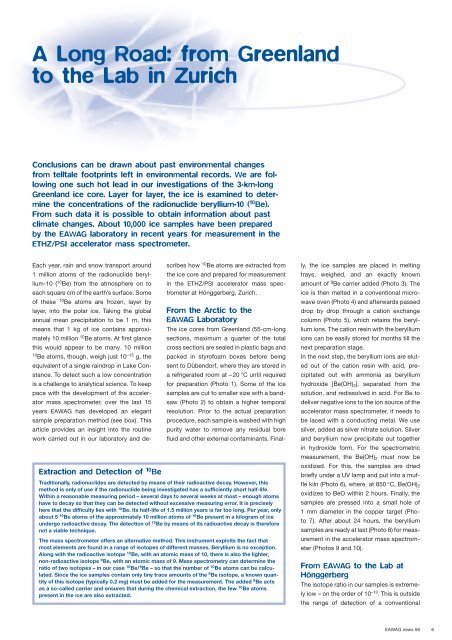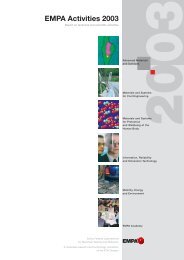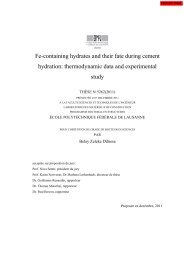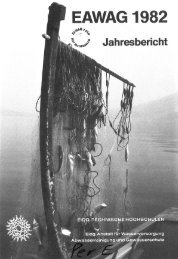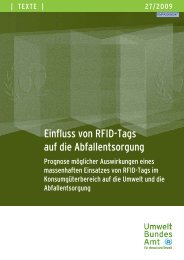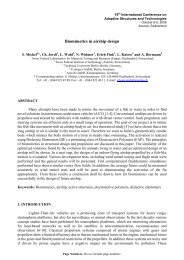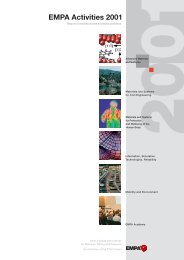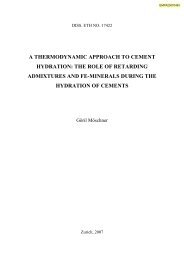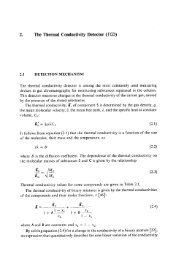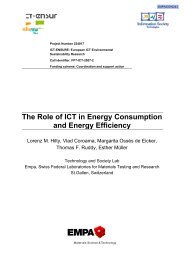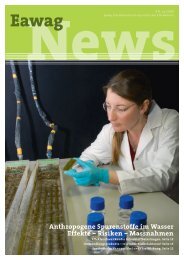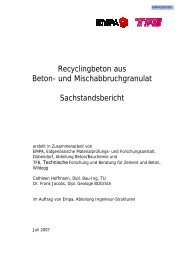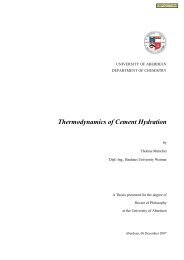Entire volume - Eawag
Entire volume - Eawag
Entire volume - Eawag
You also want an ePaper? Increase the reach of your titles
YUMPU automatically turns print PDFs into web optimized ePapers that Google loves.
A Long Road: from Greenland<br />
to the Lab in Zurich<br />
Conclusions can be drawn about past environmental changes<br />
from telltale footprints left in environmental records. We are following<br />
one such hot lead in our investigations of the 3-km-long<br />
Greenland ice core. Layer for layer, the ice is examined to determine<br />
the concentrations of the radionuclide beryllium-10 ( 10 Be).<br />
From such data it is possible to obtain information about past<br />
climate changes. About 10,000 ice samples have been prepared<br />
by the EAWAG laboratory in recent years for measurement in the<br />
ETHZ/PSI accelerator mass spectrometer.<br />
Each year, rain and snow transport around<br />
1 million atoms of the radionuclide beryllium-10<br />
( 10Be) from the atmosphere on to<br />
each square cm of the earth’s surface. Some<br />
of these 10Be atoms are frozen, layer by<br />
layer, into the polar ice. Taking the global<br />
annual mean precipitation to be 1 m, this<br />
means that 1 kg of ice contains approximately<br />
10 million 10Be atoms. At first glance<br />
this would appear to be many. 10 million<br />
10Be atoms, though, weigh just 10 –15 g, the<br />
equivalent of a single raindrop in Lake Constance.<br />
To detect such a low concentration<br />
is a challenge to analytical science. To keep<br />
pace with the development of the accelerator<br />
mass spectrometer, over the last 15<br />
years EAWAG has developed an elegant<br />
sample preparation method (see box). This<br />
article provides an insight into the routine<br />
work carried out in our laboratory and de-<br />
Extraction and Detection of 10 Be<br />
scribes how 10Be atoms are extracted from<br />
the ice core and prepared for measurement<br />
in the ETHZ/PSI accelerator mass spectrometer<br />
at Hönggerberg, Zurich.<br />
From the Arctic to the<br />
EAWAG Laboratory<br />
The ice cores from Greenland (55-cm-long<br />
sections, maximum a quarter of the total<br />
cross section) are sealed in plastic bags and<br />
packed in styrofoam boxes before being<br />
sent to Dübendorf, where they are stored in<br />
a refrigerated room at –20 °C until required<br />
for preparation (Photo 1). Some of the ice<br />
samples are cut to smaller size with a bandsaw<br />
(Photo 2) to obtain a higher temporal<br />
resolution. Prior to the actual preparation<br />
procedure, each sample is washed with high<br />
purity water to remove any residual bore<br />
fluid and other external contaminants. Final-<br />
Traditionally, radionuclides are detected by means of their radioactive decay. However, this<br />
method is only of use if the radionuclide being investigated has a sufficiently short half-life.<br />
Within a reasonable measuring period – several days to several weeks at most – enough atoms<br />
have to decay so that they can be detected without excessive measuring error. It is precisely<br />
here that the difficulty lies with 10 Be. Its half-life of 1.5 million years is far too long. Per year, only<br />
about 5 10 Be atoms of the approximately 10 million atoms of 10 Be present in a kilogram of ice<br />
undergo radioactive decay. The detection of 10 Be by means of its radioactive decay is therefore<br />
not a viable technique.<br />
The mass spectrometer offers an alternative method. This instrument exploits the fact that<br />
most elements are found in a range of isotopes of different masses. Beryllium is no exception.<br />
Along with the radioactive isotope 10 Be, with an atomic mass of 10, there is also the lighter,<br />
non-radioactive isotope 9 Be, with an atomic mass of 9. Mass spectrometry can determine the<br />
ratio of two isotopes – in our case 10 Be/ 9 Be – so that the number of 10 Be atoms can be calculated.<br />
Since the ice samples contain only tiny trace amounts of the 9 Be isotope, a known quantity<br />
of this isotope (typically 0.2 mg) must be added for the measurement. The added 9 Be acts<br />
as a so-called carrier and ensures that during the chemical extraction, the few 10 Be atoms<br />
present in the ice are also extracted.<br />
ly, the ice samples are placed in melting<br />
trays, weighed, and an exactly known<br />
amount of 9Be carrier added (Photo 3). The<br />
ice is then melted in a conventional microwave<br />
oven (Photo 4) and afterwards passed<br />
drop by drop through a cation exchange<br />
column (Photo 5), which retains the beryllium<br />
ions. The cation resin with the beryllium<br />
ions can be easily stored for months till the<br />
next preparation stage.<br />
In the next step, the beryllium ions are eluted<br />
out of the cation resin with acid, precipitated<br />
out with ammonia as beryllium<br />
hydroxide [Be(OH) 2], separated from the<br />
solution, and redissolved in acid. For Be to<br />
deliver negative ions to the ion source of the<br />
accelerator mass spectrometer, it needs to<br />
be laced with a conducting metal. We use<br />
silver, added as silver nitrate solution. Silver<br />
and beryllium now precipitate out together<br />
in hydroxide form. For the spectrometric<br />
measurement, the Be(OH) 2 must now be<br />
oxidized. For this, the samples are dried<br />
briefly under a UV lamp and put into a muffle<br />
kiln (Photo 6), where, at 850 °C, Be(OH) 2<br />
oxidizes to BeO within 2 hours. Finally, the<br />
samples are pressed into a small hole of<br />
1 mm diameter in the copper target (Photo<br />
7). After about 24 hours, the beryllium<br />
samples are ready at last (Photo 8) for measurement<br />
in the accelerator mass spectrometer<br />
(Photos 9 and 10).<br />
From EAWAG to the Lab at<br />
Hönggerberg<br />
The isotope ratio in our samples is extremely<br />
low – on the order of 10 –13 . This is outside<br />
the range of detection of a conventional<br />
EAWAG news 58 6


